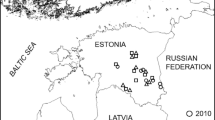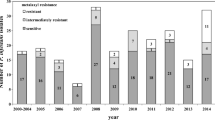Abstract
This is the first characterisation of Lithuanian populations of Phytophthora infestans with mating type and virulence on a differential set of 11 R genes of Solanum demissum. The sensitivity to metalaxyl was also determined. In 2010–2012, 93 Phytophthora infestans isolates, collected from all over Lithuania, showed quite high and stable frequency of A2 mating type. On 45% of all studied potato fields, both mating types were recorded, suggesting sexual reproduction of P. infestans and possible oospore production in Lithuanian potato fields. Fourteen metalaxyl-resistant isolates were found among 71 isolates in the current study period, and sensitive isolates prevailed in all three years. Amongst the studied 70 isolates, 38 avirulence pathotypes were found. The Lithuanian race structure was highly diverse and complex (the average number of missing avirulence factors per isolate was 7.2). Most pathotypes were unique, appearing only once, and the four most common pathotypes comprised only 34% of the population.
Similar content being viewed by others
References
Andrivon D, Avendano-Córcoles J, Cameron AM, Carnegie SF, Cooke LR, Corbière R, Detournè D, Dowley LJ, Evans D, Forisekova K, Griffin DG, Hannukkala A, Lees AK, Lebecka R, Niepold F, Polgar Z, Shawn DS, Thompson J, Trognitz B, van Raaij HMG & Zimnock-Guzowska E, 2011. Stability and variability of virulence of Phytophthora infestans assessed in a ring test across European laboratories. Plant Pathol 60, 556–565.
Asakavičiūtė R, Ražukas A & Jundulas J, 2009. Susceptibility of new potato varieties to the potato late blight oomycete Phytophthora infestans (Mont.) de Bary in Lithuania. Agrociencia 43, 625–633.
Bouws H & Finckh MR, 2007. Effects of cropping history and origin of seed potatoes on population structure of Phytophthora infestans. Eur J Plant Pathol 117, 313–327.
Chmielarz M, Sobkowiak S, Dębski K, Cooke DEL & Brurberg MB & Śliwka J, 2014. Diversity of Phytophthora infestans from Poland. Plant Pathol 63, 203–2011.
Cooke DEL, Cano LM, Raffaele S, Bain RA, Cooke LR, Etherington GJ, Deahl KL, Farrer RA, Gilroy EM, Goss EM, Grünwald NJ, Hein I, MacLean D, McNicol JW, Randall E, Oliva RF, Pel MA, Shaw DS, Squires JN, Taylor MC, Vleeshouwers VGAA, Birch PRJ, Lees AK & Kamoun S, 2012. Genome analyses of an aggressive and invasive lineage of the Irish potato famine pathogen. PLoS Pathogens 8(10), e1002940.
Cooke LR, Carlisle DJ, Donaghy C, Quinn M, Perez FM & Deahl KL, 2006. The Northern Ireland Phytophthora infestans population 1998–2002 characterized by genotypic and phenotypic markers. Plant Pathol 55, 320–330.
Cooke LR, Schepers HTM, Hermansen A, Bain RA, Bradshaw NJ, Ritchie F, Shaw DS, Evenhuis A, Kessel GJT, Wander JGN, Anderson B, Hansen JG, Hannukkala A & Nærstad R & Nielsen BJ, 2011. Epidemiology and integrated control of potato late blight in Europe. Potato Res 54, 183–222.
Day JP, Wattier RAM, Shaw DS & Shattock RC, 2004. Phenotypic and genotypic diversity in Phytophthora infestans on potato in Great Britain, 1995–98. Plant Pathol 53, 303–315.
Fry WE & Goodwin SB. 1997. Re-emergence of potato and tomato late blight in the United States. Plant Dis 81, 1349–1357.
Gisi U, Walder F, Resheat-Eini Z, Edel D & Sierotzki H, 2011. Changes of genotype, sensitivity and aggressiveness in Phytophthora infestans isolates collected in European countries in 1997, 2006 and 2007. J Phytopathol 159, 223–232.
Hannukkala AO, 2012. Historyand consequences of migrations, changes in epidemiology and population structure of potato late blight, Phytophthora infestans, in Finland from 1845 to 2011. Doctoral Dissertation. MTT Science 18. MTT Agrifood Research Finland, Jokioinen, 136 p. Available at http://www.mtt.fi/mtttiede/pdf/mtttiede18.pdf.
Hermansen A, Hannukkala A, Hafskjold Naerstad R & Brurberg MB, 2000. Variation in populations of Phytophthora infestans in Finland and Norway: mating type, metalaxyl resistance and virulence phenotype. Plant Pathol 49, 11–22.
Knapova G & Gisi U, 2002. Phenotypic and genotypic structure of Phytophthora infestans populations on potato and tomato in France and Switzerland. Plant Pathol 51, 641–653.
Kuznetsova MA, Ulanova TI, Rogozhin AN, Smetanina TI & Filippov AV, 2010. Role of oospores in the overwintering and year-on-year development of the late blight pathogen on tomato in potato. Proceedings of the Twelfth EuroBlight Workshop 2010, Arras, France, PPO Special Report 14, 223–230.
Lehtinen A, Hannukkala A, Rantanen T & Jauhiainen L, 2007. Phenotypic and genetic variation in Finnish potato-late blight populations, 1997–2000. Plant Pathol 56, 480–491.
Lehtinen A, Hannukkala A, Andersson B, Hermansen A, Le VH, Naerstad R, Brurberg MB, Nielsen BJ, Hansen JG & Yuen J, 2008. Phenotypic variation in Nordic populations of Phytophthora infestans in 2003. Plant Pathol 57, 227–234.
Li Y, van der Lee TAJ, Evenhuis A, van den Bosch GBM, van Bekkum PJ, Förch MG, van Gent-Pelzer MPE, van Raaji HMG, Jacobsen E, Huang SW, Govers F, Vleeshouwers VGAA & Kessel GJT, 2012. Population dynamics of Phytophthora infestans in the Netherlands reveals expansion and spread of dominant clonal lineages and virulence in sexual offspring. G3: Genes Genom Genet 2, 1529–1540.
Malcolmson JF & Black W, 1966. New R genes in Solanum demissum Lindl. and their complementary races of Phytophthora infestans (Mont.) de Bary. Euphytica 15, 199–203.
Mazakova J, Taborsky V, Zouhar M, Ryšanek P, Hausvater E & Doležal P, 2006. Occurrence and distribution of mating types A1 and A2 of Phytophthora infestans (Mont.) de Bary in the Czech Republic. Plant Prot Sci 42, 41–48.
Mazakova J, Zouhar M, Ryšanek P, Taborsky V, Hausvater E & Doležal P, 2011. Sensitivity to fungicides in the isolates of Phytophthora infestans (Mont.) de Bary in the Czech Republic from 2003 to 2008. Plant Prot Sci 47, 5–12.
Pobedinskaya MA, Elansky SN, Statsyuk NV & Plyakhnevich MP, 2011. Fungicide resistance of Russian Phytophthora infestans strains. Proceedings of the Thirteenth EuroBlight Workshop 2011, St. Petersburg, Russia, PPO Special Report 15, 243–248.
Ronis A & Tamošiūnas K, 2005. The comparison of the decision support systems “NegFry” and “PLANT PLUS” for the control of late blight in Lithuania. Scientific works of the Lithuanian Institute of Horticulture and Lithuanian University of Agriculture — Horticulture and vegetable growing 24, 362–370.
Ronis A, Rainys K, Semaškienė R & Lazauskas S, 2007. Potato late blight in Lithuania. Proceedings of the Twelfth EuroBlight Workshop 2010, Bologna, Italy, PPO Special Report12, 303–309.
Runno-Paurson E, Fry WE, Myers KL, Koppel M & Mänd M, 2009. Characterization of Phytophthora infestans isolates collected from potato in Estonia during 2002–2003. Eur J Plant Pathol 124, 565–575.
Runno-Paurson E, Remmel T, Ojarand A, Aav A & Mänd M, 2010. The structure of the Phytophthora infestans population in organic and conventional crops in Estonia. Eur J Plant Pathol 128, 373–383.
Runno-Paurson E, Kotkas K, Tähtjärv T, Williams IH & Mänd M, 2011. Temporal changes in phenotypic diversity of Phytophthora infestans in northern Estonia. Žemdirbyste-Agriculture 98, 205–212.
Runno-Paurson E, Hannukkala A, Williams I, Koppel M & Mänd M, 2012. The structure of mating type, virulence, metalaxyl resistance of Phytophthora infestans in a longterm phenotypic study in distinct location in eastern Estonia. J Plant Dis Protect 119, 45–52.
Runno-Paurson E, Williams I, Metspalu L, Kaart T & Mänd M, 2013a. Current potato varieties are too susceptible to late blight to be grown without chemical control under NorthEast European conditions. Acta Agric Scand B 63, 80–88.
Runno-Paurson E, Hannukkala A, Williams I, Koppel M & Mänd M, 2013b. Impact of phytosanitary quality of seed potato and temporal epidemic progress on the phenotypic diversity of Phytophthora infestans populations. Am J Potato Res 90, 245–254.
Runno-Paurson E, Hannukkala A, Kotkas K, Koppel M, Williams IH & Mänd M, 2014. Population changes and phenotypic diversity of Phytophthora infestans isolates from Estonia and Finland. J Plant Pathol 96, 1–11.
Sheldon AL, 1969. Equitability indices: Dependence on the species count. Ecology 50, 466–467.
Sjöholm L, Andersson B, Högberg N, Widmark A-K & Yuen J, 2013. Genotypic diversity and migration patterns of Phytophthora infestans in the Nordic countries. Fungal Biol 117, 722–730.
Śliwka J, Sobkowiak S, Lebecka R, Avendańo Córcoles J & Zimnoch-Guzowska E, 2006. Mating type, virulence, aggressiveness and metalaxyl resistance of isolates of Phytophthora infestans in Poland. Potato Res 49, 155–166.
Statsyuk NV, Kozlovskaya IN, Koslovsky BE, Ulanova TI, Morozova EV & Kuznetsova M, 2013. Changes in phenotypic characteristics of the Moscow Phytophthora infestans population in the period of 2000–2011. Proceedings of 4 th International Symposium ”Agrosym 2013“, Jahorina, Bosnia and Herzegovina 607–613.
Turkensteen LJ, Flier WG, Wanningen R & Mulder A. 2000. Production, survival and infectivity of oospores of Phytophthora infestans. Plant Pathol 49, 688–696.
Valskytè A, 2000. The resistance of Phytophthora infestans population to metalaxyl in Lithuania. Proceedings of International Conference Development of Friendly Plant Protection in the Baltic Region, Tartu, Estonia 224–226.
Yuen JE & Andersson B, 2013. What is the evidence for sexual reproduction of Phytophthora infestans in Europe? Plant Pathol 62, 485–491.
Author information
Authors and Affiliations
Corresponding author
Rights and permissions
About this article
Cite this article
Runno-Paurson, E., Ronis, A., Hansen, M. et al. Lithuanian Populations of Phytophthora infestans Revealed a High Phenotypic Diversity. J Plant Dis Prot 122, 57–65 (2015). https://doi.org/10.1007/BF03356532
Received:
Accepted:
Published:
Issue Date:
DOI: https://doi.org/10.1007/BF03356532




